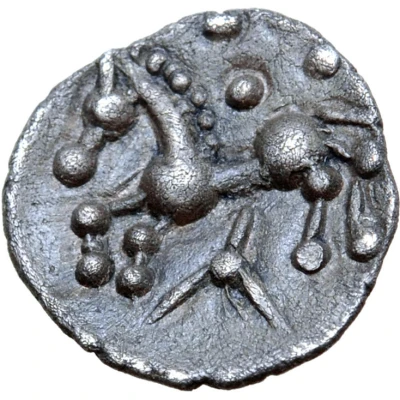


© Roma Numismatics Limited
Obol Manching 2 Type 100 BC - 1 BC
| Silver | 0.42 g | 10 mm |
| Issuer | Vindelici of Germania |
|---|---|
| Type | Standard circulation coin |
| Years | 100 BC - 1 BC |
| Value | 1 Obol (⅙) |
| Currency | Drachm |
| Composition | Silver |
| Weight | 0.42 g |
| Diameter | 10 mm |
| Shape | Round (irregular) |
| Technique | Hammered |
| Demonetized | Yes |
| Updated | 2024-10-09 |
| Numista | N#189326 |
|---|---|
| Rarity index | 100% |
Reverse
Horse to left with pellet mane, three pellets above, pointed object below.
Comment
Cf. Kellner, Manching pl. 42, 963;Examples of this type:
• Example #1 (0.42g, 10mm, 9h; Good Extremely Fine):
© Image courtesy of Roma Numismatics Limited
◦ Ex-Hermann Lanz Collection; published in Kostial #22
◦ Exhibited by the Staatlichen Münzsammlung München at the 1997 International Numismatic Congress in Berlin; at the Berliner Bank also in 1997; also exhibited at the Luitpoldblock Palmengarten, Munich in 2003 (exhibition #12[reverse]).
◦ Auctioned by Roma Numismatics Ltd, Auction XVIII, 29 September 2019, lot 10. Sold for 220 GBP.
• Example #1 (0.33g, 8mm, 2h; Near Extremely Fine):
© Image courtesy of Roma Numismatics Limited
◦ Ex-Hermann Lanz Collection; published in Kostial #21;
◦ Exhibited by the Staatlichen Münzsammlung München at the 1997 International Numismatic Congress in Berlin; at the Berliner Bank also in 1997; also exhibited at the Luitpoldblock Palmengarten, Munich in 2003 (exhibition #13[reverse]).
◦ Auctioned by Roma Numismatics Ltd, Auction XVII, 28 March 2019, lot 10. Estimated at 50 GBP, Unsold.
Interesting fact
One interesting fact about the Obol (Manching 2 Type) coin from Vindelici of Germania is that it features a unique combination of Celtic and Roman influences in its design. The coin's obverse side bears a stylized head of the Celtic goddess Epona, while the reverse side features a stylized image of a Roman fasces, a symbol of Roman authority and power. This blending of cultural influences reflects the complex history of the region and the interactions between the Celtic and Roman civilizations during that time.



